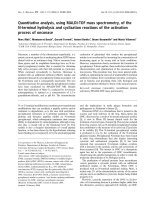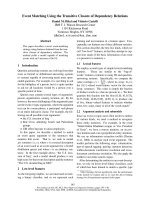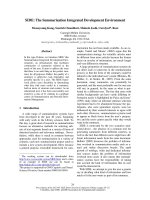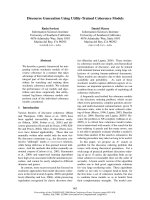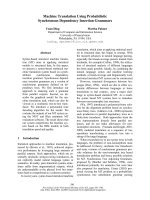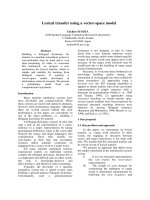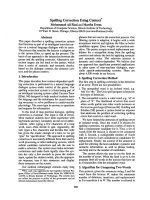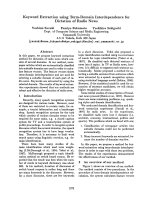Báo cáo khoa học: "Multi-Document Summarization using Sentence-based Topic Models" docx
Bạn đang xem bản rút gọn của tài liệu. Xem và tải ngay bản đầy đủ của tài liệu tại đây (807.21 KB, 4 trang )
Proceedings of the ACL-IJCNLP 2009 Conference Short Papers, pages 297–300,
Suntec, Singapore, 4 August 2009.
c
2009 ACL and AFNLP
Multi-Document Summarization using Sentence-based Topic Models
Dingding Wang
1
Shenghuo Zhu
2
Tao Li
1
Yihong Gong
2
1. School of Computer Science, Florida International University, Miami, FL, 33199
2. NEC Laboratories America, Cupertino, CA 95014, USA.
{dwang003,taoli}@cs.fiu.edu {zsh,ygong}@sv.nec-labs.com
Abstract
Most of the existing multi-document
summarization methods decompose the
documents into sentences and work
directly in the sentence space using a
term-sentence matrix. However, the
knowledge on the document side, i.e. the
topics embedded in the documents, can
help the context understanding and guide
the sentence selection in the summariza-
tion procedure. In this paper, we propose a
new Bayesian sentence-based topic model
for summarization by making use of both
the term-document and term-sentence
associations. An efficient variational
Bayesian algorithm is derived for model
parameter estimation. Experimental
results on benchmark data sets show the
effectiveness of the proposed model for
the multi-document summarization task.
1 Introduction
With the continuing growth of online text
resources, document summarization has found
wide-ranging applications in information retrieval
and web search. Many multi-document summa-
rization methods have been developed to extract
the most important sentences from the documents.
These methods usually represent the documents
as term-sentence matrices (where each row rep-
resents a sentence and each column represents a
term) or graphs (where each node is a sentence
and each edge represents the pairwise relationship
among corresponding sentences), and ranks the
sentences according to their scores calculated by a
set of predefined features, such as term frequency-
inverse sentence frequency (TF-ISF) (Radev et al.,
2004; Lin and Hovy, 2002), sentence or term
position (Yih et al., 2007), and number of key-
words (Yih et al., 2007). Typical existing summa-
rization methods include centroid-based methods
(e.g., MEAD (Radev et al., 2004)), graph-ranking
based methods (e.g., LexPageRank (Erkan and
Radev, 2004)), non-negative matrix factorization
(NMF) based methods (e.g., (Lee and Seung,
2001)), Conditional random field (CRF) based
summarization (Shen et al., 2007), and LSA based
methods (Gong and Liu, 2001).
There are two limitations with most of the exist-
ing multi-document summarization methods: (1)
They work directly in the sentencespace and many
methods treat the sentences as independent of each
other. Although few work tries to analyze the
context or sequence information of the sentences,
the document side knowledge, i.e. the topics em-
bedded in the documents are ignored. (2) An-
other limitation is that the sentence scores calcu-
lated from existing methods usually do not have
very clear and rigorous probabilistic interpreta-
tions. Many if not all of the sentence scores
are computed using various heuristics as few re-
search efforts have been reported on using genera-
tive models for document summarization.
In this paper, to address the above issues,
we propose a new Bayesian sentence-based topic
model for multi-document summarization by mak-
ing use of both the term-document and term-
sentence associations. Our proposal explicitly
models the probability distributions of selecting
sentences given topics and provides a principled
way for the summarization task. An efficient vari-
ational Bayesian algorithm is derived for estimat-
ing model parameters.
2 Bayesian Sentence-based Topic Models
(BSTM)
2.1 Model Formulation
The entire document set is denoted by D. For each
document d ∈ D, we consider its unigram lan-
guage model,
297
p(W
n
1
|θ
d
) =
n
i=1
p(W
i
|θ
d
),
where θ
d
denotes the model parameter for docu-
ment d, W
n
1
denotes the sequence of words {W
i
∈
W}
n
i=1
, i.e. the content of the document. W is the
vocabulary. As topic models, we further assume
the unigram model as a mixture of several topic
unigram models,
p(W
i
|θ
d
) =
T
i
∈T
p(W
i
|T
i
)p(T
i
|θ
d
),
where T is the set of topics. Here, we assume
that given a topic, generating words is independent
from the document, i.e.
p(W
i
|T
i
, θ
d
) = p(W
i
|T
i
).
Instead of freely choosing topic unigram mod-
els, we further assume that topic unigram models
are mixtures of some existing base unigram mod-
els, i.e.
p(W
i
|T
i
) =
s∈S
p(W
i
|S
i
= s)p(S
i
= s|T
i
),
where S is the set of base unigram models. Here,
we use sentence language models as the base mod-
els. One benefit of this assumption is that each
topic is represented by meaningful sentences, in-
stead of directly by keywords. Thus we have
p(W
i
|θ
d
) =
t∈T
s∈S
p(W
i
|S
i
= s)p(S
i
= s|T
i
= t)p(T
i
= t|θ
d
).
Here we use parameter U
st
for the probability
of choosing base model s given topic t, p(S
i
=
s|T
i
= t) = U
st
, where
s
U
st
= 1. We use
parameters {θ
d
} for the probability of choosing
topic t given document d, where
t
Θ
dt
= 1.
We assume that the parameters of base models,
{B
ws
}, are given, i.e. p(W
i
= w|S
i
= s) = B
ws
,
where
w
B
ws
= 1. Usually, we obtain B
ws
by
empirical distribution words of sentence s.
2.2 Parameter Estimation
For summarization task, we concern how to de-
scribe each topic with the given sentences. This
can be answered by the parameter of choosing
base model s given topic t, U
st
. Comparing to
parameter U
st
, we concern less about the topic
distribution of each document, i.e. Θ
dt
. Thus
we choose Bayesian framework to estimate U
st
by
marginalizing Θ
dt
. To do so, we assume a Dirich-
let prior for Θ
d·
∼ Dir(α), where vector α is a
hyperparameter. Thus the likelihood is
f(U; Y) =
d
i
p(Y
id
|θ
d
)π (θ
d
|α)dθ
d
= B(α)
−D
id
[BUΘ
]
Y
id
id
×
dk
Θ
α
k
−1
dk
d Θ.
(1)
As Eq. (1) is intractable, LDA (Blei et al., 2001)
applies variational Bayesian, which is to maximize
a variational bound of the integrated likelihood.
Here we write the variational bound.
Definition 1 The variational bound is
f(U, V; Y) =
d
B(α + γ
d,·
)
B(α)
vkwd
B
wv
U
vk
φ
vk;wd
Y
wd
φ
vk;wd
(2)
where the domain of V isV = {V ∈ R
D×K
+
:
k
V
dk
=
1}, φ
vk;wd
= B
wv
U
vk
V
dk
/[BUV
]
wd
, γ
dk
=
wv
Y
wd
φ
vk;wd
.
We have the following proposition.
Proposition 1 f (U; Y) ≥ sup
V∈V
f(U, V; Y).
Actually the optimum of this variational bound is
the same as that obtained variational Bayesian ap-
proach. Due to the space limit, the proof of the
proposition is omitted.
3 The Iterative Algorithm
The LDA algorithm (Blei et al., 2001) em-
ployed the variational Bayesian paradigm, which
estimates the optimal variation bound for each U.
The algorithm requires an internal Expectation-
Maximization (EM) procedure to find the optimal
variational bound. The nested EM slows down
the optimization procedure. To avoid the internal
EM loop, we can directly optimize the variational
bound to obtain the update rules.
3.1 Algorithm Derivation
First, we define the concept of Dirichlet adjust-
ment, which is used in the algorithm for vari-
ational update rules involving Dirichlet distribu-
tion. Then, we define some notations for the up-
date rules.
Definition 2 We call vector y of size K is the
Dirichlet adjustment of vector x of size K with re-
spect to Dirichlet distribution D
K
(α) if
y
k
= exp(Ψ(α
k
+ x
k
) − Ψ(
l
(α
l
+ x
l
))),
where Ψ(·) is digamma function. We denote it by
y = P
D
(x; α).
We denote element-wise product of matrix X and
matrix Y by X ◦ Y, element-wise division by
X
Y
, obtaining Y via normalizing of each column
of X as Y
1
← X, and obtaining Y via Dirich-
let adjustment P
D
(·; α) and normalization of each
row of X as
P
D
(·;α),2
←− , i.e., z = P
D
((X
d,·
)
; α) and
Y
d,k
= z
k
/
k
z
k
. The following is the update rules
for LDA:
U
1
← B
Y
B
U
V
V ◦
U (3)
V
P
D
(·;α),2
←
Y
BU
V
(BU) ◦
V (4)
298
Algorithm 1 Iterative Algorithm
Input: Y : term-document matrix
B : term-sentence matrix
K : the number of latent topics
Output: U : sentence-topic matrix
V : auxiliary document-topic matrix
1: Randomly initialize U and V, and normalize them
2: repeat
3: Update U using Eq. (3);
4: Update V using Eq. (4);
5: Compute
f using Eq. (2);
6: until
f converges.
3.2 Algorithm Procedure
The detail procedure is listed as Algorithm 1.
¿From the sentence-topic matrix U, we include
the sentence with the highest probability in each
topic into the summary.
4 Relations with Other Models
In this section, we discuss the connections and
differences of our BSTM model with two related
models.
Recently, a new language model, factorization
with sentence bases (FGB) (Wang et al., 2008) is
proposed for document clustering and summariza-
tion by making use of both term-document matrix
Y and term-sentence matrix B. The FGB model
computes two matrices U and V by optimizing
U, V = arg min
U,V
(U, V),
where
(U, V) = KL
YBUV
− ln Pr(U, V).
Here, Kullback-Leibler divergence is used to mea-
sure the difference between the distributions of Y
and the estimated BUV
. Our BSTM is similar
to the FGB summarization since they are all based
on sentence-based topic model. The difference is
that the document-topic allocation V is marginal-
ized out in BSTM. The marginalization increases
the stability of the estimation of the sentence-topic
parameters. Actually, from the algorithm we can
see that the difference lies in the Dirichlet adjust-
ment. Experimental results show that our BSTM
achieves better summarization results than FGB
model.
Our BSTM model is also related to 3-
factor non-negative matrix factorization (NMF)
model (Ding et al., 2006) where the problem is to
solve U and V by minimizing
F
(U, V) = Y − BUV
2
F
. (5)
Both BSTM and NMF models are used for solv-
ing U and V and have similar multiplicative up-
date rules. Note that if the matrix B is the identity
matrix, Eq. (5) leads to the derivation of the NMF
algorithm with Frobenius norm in (Lee and Seung,
2001). However, our BSTM model is a generative
probabilistic model and makes use of Dirichlet ad-
justment. The results obtained in our model have
clear and rigorous probabilistic interpretations that
the NMF model lacks. In addition, by marginaliz-
ing out V, our BSTM model leads to better sum-
marization results.
5 Experimental Results
5.1 Data Set
To evaluate the summarization results empirically,
we use the DUC2002 and DUC2004 data sets,
both of which are open benchmark data sets from
Document Understanding Conference (DUC) for
generic automatic summarization evaluation. Ta-
ble 1 gives a brief description of the data sets.
DUC2002 DUC2004
number of
document collections 59 50
number of documents ∼10 10
in each collection
data source TREC TDT
summary length 200 words 665bytes
Table 1: Description of the data sets for multi-document
summarization
Systems ROUGE-1 ROUGE-2 ROUGE-L ROUGE-SU
DUC Best 0.49869 0.25229 0.46803 0.28406
Random 0.38475 0.11692 0.37218 0.18057
Centroid 0.45379 0.19181 0.43237 0.23629
LexPageRank 0.47963 0.22949 0.44332 0.26198
LSA 0.43078 0.15022 0.40507 0.20226
NMF 0.44587 0.16280 0.41513 0.21687
KM 0.43156 0.15135 0.40376 0.20144
FGB 0.48507 0.24103 0.45080 0.26860
BSTM 0.48812 0.24571 0.45516 0.27018
Table 2: Overall performance comparison on DUC2002
data using ROUGE evaluation methods.
Systems ROUGE-1 ROUGE-2 ROUGE-L ROUGE-SU
DUC Best 0.38224 0.09216 0.38687 0.13233
Random 0.31865 0.06377 0.34521 0.11779
Centroid 0.36728 0.07379 0.36182 0.12511
LexPageRank 0.37842 0.08572 0.37531 0.13097
LSA 0.34145 0.06538 0.34973 0.11946
NMF 0.36747 0.07261 0.36749 0.12918
KM 0.34872 0.06937 0.35882 0.12115
FGB 0.38724 0.08115 0.38423 0.12957
BSTM 0.39065 0.09010 0.38799 0.13218
Table 3: Overall performance comparison on DUC2004 data using
ROUGE evaluation methods.
5.2 Implemented Systems
We implement the following most widely used
document summarization methods as the base-
line systems to compare with our proposed BSTM
method. (1) Random: The method selects sen-
tences randomly for each document collection.
299
(2) Centroid: The method applies MEAD algo-
rithm (Radev et al., 2004) to extract sentences ac-
cording to the following three parameters: cen-
troid value, positional value, and first-sentence
overlap. (3) LexPageRank: The method first con-
structs a sentence connectivity graph based on
cosine similarity and then selects important sen-
tences based on the concept of eigenvector cen-
trality (Erkan and Radev, 2004). (4) LSA: The
method performs latent semantic analysis on terms
by sentences matrix to select sentences having
the greatest combined weights across all impor-
tant topics (Gong and Liu, 2001). (5) NMF: The
method performs non-negative matrix factoriza-
tion (NMF) on terms by sentences matrix and then
ranks the sentences by their weighted scores (Lee
and Seung, 2001). (6) KM: The method performs
K-means algorithm on terms by sentences matrix
to cluster the sentences and then chooses the cen-
troids for each sentence cluster. (7) FGB: The
FGB method is proposed in (Wang et al., 2008).
5.3 Evaluation Measures
We use ROUGE toolkit (version 1.5.5) to measure
the summarization performance, which is widely
applied by DUC for performance evaluation. It
measures the quality of a summary by counting the
unit overlaps between the candidate summary and
a set of reference summaries. The full explanation
of the evaluation toolkit can be found in (Lin and
E.Hovy, 2003). In general, the higher the ROUGE
scores, the better summarization performance.
5.4 Result Analysis
Table 2 and Table 3 show the comparison results
between BSTM and other implemented systems.
From the results, we have the follow observa-
tions: (1) Random has the worst performance.
The results of LSA, KM, and NMF are similar
and they are slightly better than those of Random.
Note that LSA and NMF provide continuous so-
lutions to the same K-means clustering problem
while LSA relaxes the non-negativity of the clus-
ter indicator of K-means and NMF relaxes the
orthogonality of the cluster indicator (Ding and
He, 2004; Ding et al., 2005). Hence all these
three summarization methods perform clustering-
based summarization: they first generate sentence
clusters and then select representative sentences
from each sentence cluster. (2) The Centroid sys-
tem outperforms clustering-based summarization
methods in most cases. This is mainly because
the Centroid based algorithm takes into account
positional value and first-sentence overlap which
are not used in clustering-based summarization.
(3) LexPageRank outperforms Centroid. This is
due to the fact that LexPageRank ranks the sen-
tence using eigenvector centrality which implic-
itly accounts for information subsumption among
all sentences (Erkan and Radev, 2004). (4) FGB
performs better than LexPageRank. Note that
FGB model makes use of both term-document and
term-sentence matrices. Our BSTM model outper-
forms FGB since the document-topic allocation is
marginalized out in BSTM and the marginaliza-
tion increases the stability of the estimation of the
sentence-topic parameters. (5) Our BSTM method
outperforms all other implemented systems and its
performance is close to the results of the best team
in the DUC competition. Note that the good per-
formance of the best team in DUC benefits from
their preprocessing on the data using deep natural
language analysis which is not applied in our im-
plemented systems.
The experimental results provide strong evi-
dence that our BSTM is a viable method for docu-
ment summarization.
Acknowledgement: The work is partially
supported by NSF grants IIS-0546280, DMS-
0844513 and CCF-0830659.
References
D. M. Blei,A. Y. Ng,and M. I.Jordan. Latent dirichlet allocation. In Advances
in Neural Information Processing Systems 14.
C. Ding and X. He. K-means clustering and principal component analysis. In
Prodeedings of ICML 2004.
Chris Ding, Xiaofeng He, and Horst Simon. 2005. On the equivalence of
nonnegative matrix factorization and spectral clustering. In Proceedings of
Siam Data Mining.
Chris Ding, Tao Li, Wei Peng, and Haesun Park. 2006. Orthogonal nonneg-
ative matrix tri-factorizations for clustering. In Proceedings of SIGKDD
2006.
G. Erkan and D. Radev. 2004. Lexpagerank: Prestige in multi-document text
summarization. In Proceedings of EMNLP 2004.
Y. Gong and X. Liu. 2001. Generic text summarization using relevance mea-
sure and latent semantic analysis. In Proceedings of SIGIR.
Daniel D. Lee and H. Sebastian Seung. Algorithms for non-negative matrix
factorization. In Advances in Neural Information Processing Systems 13.
C-Y. Lin and E.Hovy. Automatic evaluation of summaries using n-gram co-
occurrence statistics. In Proceedings of NLT-NAACL 2003.
C-Y. Lin and E. Hovy. 2002. From single to multi-document summarization:
A prototype system and its evaluation. In Proceedings of ACL 2002.
I. Mani. 2001. Automatic summarization. John Benjamins Publishing Com-
pany.
D. Radev, H. Jing, M. Stys, and D. Tam. 2004. Centroid-based summarization
of multiple documents. Information Processing and Management, pages
919–938.
B. Ricardo and R. Berthier. 1999. Modern information retrieval. ACM Press.
D. Shen, J-T. Sun, H. Li, Q. Yang, and Z. Chen. 2007. Document summariza-
tion using conditional random fields. In Proceedings of IJCAI 2007.
Dingding Wang, Shenghuo Zhu, Tao Li, Yun Chi, and Yihong Gong. 2008.
Integrating clustering and multi-document summarization to improve doc-
ument understanding. In Proceedings of CIKM 2008.
W-T. Yih, J. Goodman, L. Vanderwende, and H. Suzuki. 2007. Multi-
document summarization by maximizing informative content-words. In
Proceedings of IJCAI 2007.
300
